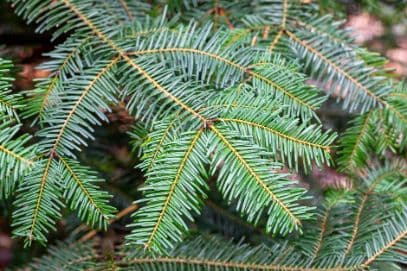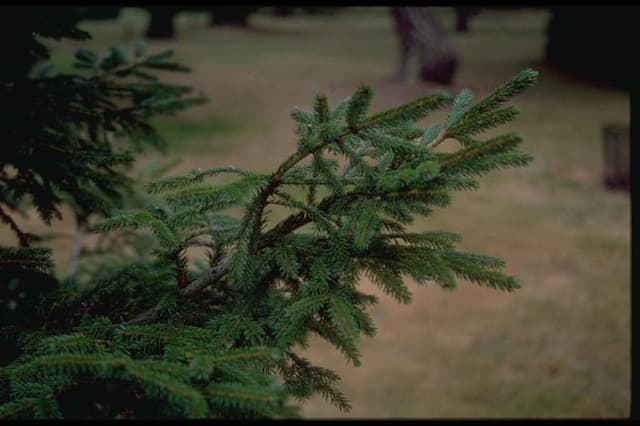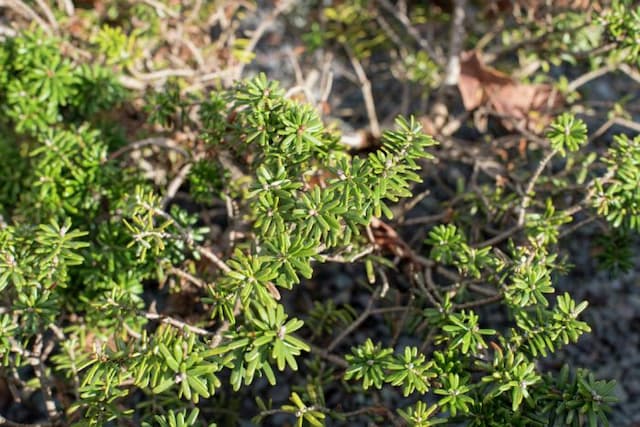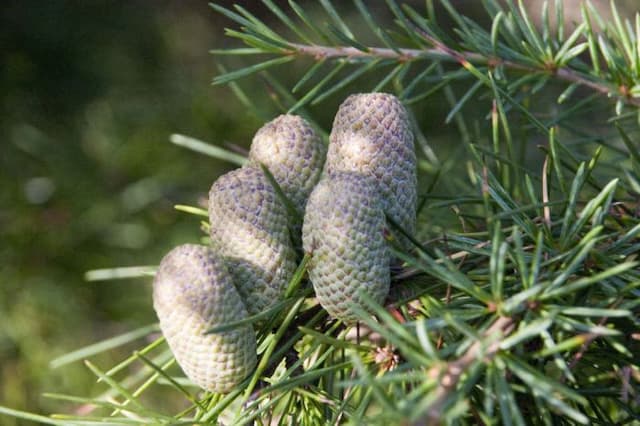Colorado Blue Spruce Picea pungens

ABOUT
The plant known commonly as the Colorado blue spruce is known for its striking appearance. It typically has a conical shape and features a dense growth of stiff, needle-like leaves. These needles are a distinctive silvery blue-green color, giving the tree its characteristic and much admired appearance. The tree’s branches grow out in a horizontal fashion, with the lower branches often drooping slightly. Each needle is sharply pointed and can be quite prickly to the touch, hence the species name that suggests a "pungent" or sharp quality. The Colorado blue spruce often has a symmetrical form, making it a popular choice for ornamental use. On the adult plant, the bark is gray-brown in color, furrowed, and it has a flaky texture. This tree also produces cones that are pendulous, with a characteristic brown color when mature, adding to its decorative quality. These cones are fairly slender and can vary in length. Overall, the Colorado blue spruce's unique color and pleasing shape are what make it quite distinctive and a favorite for use in landscaping as ornamental trees across various regions beyond its native habitat.
About this plant
 Names
NamesFamily
Pinaceae.
Synonyms
Colorado Spruce, Blue Spruce, Green Spruce, White Spruce, Colorado Blue Spruce, Silver Spruce.
Common names
Picea parryana, Picea menziesii, Picea glauca var. pungens, Picea pungens var. parryana.
 Toxicity
ToxicityTo humans
The Picea pungens, commonly known as the Blue Spruce, is generally not considered toxic to humans. However, ingestion of parts of the plant is not advisable as plant material can cause mild gastrointestinal upset due to the indigestible nature of the foliage.
To pets
The Blue Spruce is not known to be highly toxic to pets. Nevertheless, if pets ingest the needles, they could experience mild gastrointestinal discomfort, such as vomiting or diarrhea, due to the plant's rough and indigestible nature. It is always best to discourage pets from chewing on ornamental plants to avoid any potential issues.
 Characteristics
CharacteristicsLife cycle
Perennials
Foliage type
Evergreen
Color of leaves
Blue-green
Height
30 60 feet (9 18 meters)
Spread
10 20 feet (3 6 meters)
Plant type
Tree
Hardiness zones
2-7
Native area
North America
Benefits
 General Benefits
General Benefits- Aesthetic Appeal: Picea pungens, commonly known as the Colorado blue spruce, adds visual interest to landscapes with its unique silvery-blue needles and classic conical shape.
- Habitat for Wildlife: It offers habitat and protection for birds and other wildlife, serving as a nesting site and refuge from predators.
- Windbreak: Its dense foliage can act as a windbreak, reducing wind speed and protecting nearby areas from harsh winds.
- Noise Reduction: The Colorado blue spruce can help dampen noise when planted in groups, creating a more tranquil outdoor environment.
- Privacy Screen: When planted in a row, these trees create a natural privacy screen, blocking unwanted views and providing a sense of seclusion.
- Shade Provider: It can offer shade in sunny areas, potentially reducing cooling costs and creating comfortable outdoor living spaces.
- Erosion Control: The tree can help prevent soil erosion with its extensive root system, particularly on sloped terrains.
- Christmas Tree: The Colorado blue spruce is a popular choice for Christmas trees due to its symmetrical form and holiday-associated appearance.
 Medical Properties
Medical Properties- Antimicrobial: Picea pungens contains compounds that may have antimicrobial properties.
- Anti-inflammatory: It may possess anti-inflammatory compounds useful in reducing inflammation.
 Air-purifying Qualities
Air-purifying QualitiesThis plant is not specifically known for air purifying qualities.
 Other Uses
Other Uses- Picea pungens, commonly known as Colorado Blue Spruce, can be used as a natural bird habitat, offering shelter and nesting opportunities for various bird species.
- The wood of Colorado Blue Spruce is often utilized in the making of musical instruments, especially soundboards for pianos and guitars due to its resonant qualities.
- Due to its sturdy nature and appealing color, Colorado Blue Spruce wood is sometimes employed in furniture making, adding a rustic touch to handcrafted pieces.
- The tree's symmetrical shape and evergreen foliage make it a popular choice for landscape design, providing year-round visual interest in gardens and parks.
- The Colorado Blue Spruce can be planted as a windbreak, its dense growth effectively reducing wind speed and protecting nearby crops or buildings.
- This species is sometimes used in bonsai culture, where its slow growth and attractive needle coloration are highly valued by enthusiasts.
- The needles of the Colorado Blue Spruce can be used for making natural dyes, imparting shades of green to wool and other fabrics.
- The strong branches of the Colorado Blue Spruce are sometimes harvested to create wreaths and other decorative items for festive occasions.
- Colorado Blue Spruce cones can be collected and used in crafting for decorative purposes or as part of educational activities for kids.
- The resilience and adaptability of the Colorado Blue Spruce make it suitable for reforestation projects and ecosystem restoration efforts, particularly in its native North American regions.
Interesting Facts
 Feng Shui
Feng ShuiThe Blue Spruce is not used in Feng Shui practice.
 Zodiac Sign Compitability
Zodiac Sign CompitabilityThe Blue Spruce is not used in astrology practice.
 Plant Symbolism
Plant Symbolism- Strength and Resilience: Picea pungens, commonly known as the Colorado Blue Spruce, often symbolizes strength and resilience because it can withstand harsh conditions and maintain its robust stature.
- Longevity: Given its potential to live for hundreds of years, the Colorado Blue Spruce represents longevity and enduring presence.
- Steadfastness: The consistent evergreen nature of this tree embodies steadiness and unwavering character throughout the seasons.
 Water
WaterThe Colorado blue spruce, or Picea pungens, should be watered deeply and infrequently to encourage a strong root system. Establishing trees require watering once or twice a week, but once the tree is established, it can generally rely on natural rainfall. During prolonged dry spells or drought, water your spruce every three to four weeks, providing one to two gallons per inch of trunk diameter at chest height. Adjust watering in response to soil conditions, ensuring it does not remain soggy, which can cause root rot.
 Light
LightThe Colorado blue spruce thrives in full sun conditions and requires at least six hours of direct sunlight daily. It is best suited for a location that offers unfiltered, full sunlight exposure throughout the day. Avoid planting it in shaded areas, as insufficient light can lead to sparse foliage and poor growth.
 Temperature
TemperatureThe Colorado blue spruce is cold-hardy and can tolerate temperatures as low as -40 to -50 degrees Fahrenheit, but it typically thrives in temperatures ranging from 20 to 70 degrees Fahrenheit. It is well-suited for USDA hardiness zones 2 through 7. Proper cold acclimatization helps ensure the spruce can withstand the lower end of this temperature range without damage.
 Pruning
PruningPruning the Colorado blue spruce is usually done to shape the tree or remove damaged or diseased branches. The best time to prune is in late winter or early spring before new growth starts. Pruning should be kept to a minimum as this tree naturally develops a pleasing conical shape. Remove only dead or broken branches unless shaping the tree for a specific landscape design.
 Cleaning
CleaningNot needed
 Soil
SoilColorado Blue Spruce favors well-draining soil with a slightly acidic to neutral pH ranging from 6.0 to 7.5. A mixture of loam, peat, and sand would provide an ideal soil composition for healthy growth and drainage.
 Repotting
RepottingFor the young Colorado Blue Spruce, repotting should be done every 3 to 4 years to encourage growth. Mature trees seldom require repotting if planted in the ground and are given enough space to expand.
 Humidity & Misting
Humidity & MistingColorado Blue Spruce prefers a natural outdoor environment and thus is tolerant of a wide range of humidity levels, but it thrives in moderate humidity that replicates its native habitats.
 Suitable locations
Suitable locationsIndoor
Place in a cool room with bright light.
Outdoor
Full sun, well-drained soil, tolerates cold and draught.
Hardiness zone
2-7 USDA
 Life cycle
Life cycleColorado blue spruce (Picea pungens) begins its life as a seed, which germinates after stratification, a cold and moist period that breaks seed dormancy. Upon germination, the seedling develops a primary root and shoots that grow towards the light, leading to the establishment of a young sapling with typical spruce needle-like leaves. As the sapling matures, it goes through a period of vegetative growth, developing a strong woody trunk, a conical shape, and a network of branches with dense, stiff, and blue-green needles. After reaching maturity, which can be several years after germination, the Colorado blue spruce becomes reproductively capable, producing both male and female cones; the male cones release pollen which is carried by wind to female cones for fertilization. Once fertilized, the female cones develop seeds over time that are eventually dispersed by wind or animal action to begin a new generation. Throughout its lifetime, which can span well over a century, the Colorado blue spruce will go through repeated cycles of vegetative growth and reproduction.
 Propogation
PropogationPropogation time
Late winter-early spring
The Colorado blue spruce, scientifically known as Picea pungens, is commonly propagated through seed sowing. The best time for sowing seeds is in spring, after a period of stratification. Seeds should be first stratified, which means they need to be kept in a cold, moist environment such as a refrigerator for about three to four weeks to mimic winter conditions. After the stratification period, seeds can be sown in well-drained soil in containers and covered with a light layer of soil to a depth around 1/4 inch (approximately 6 millimeters). Water the seeds gently to keep the soil moist but not waterlogged, and place the containers in a location with indirect light and a consistent temperature. Germination typically occurs in 2 to 4 weeks, but can sometimes take longer. After the seedlings have grown strong enough, they can be transplanted to their permanent locations.









